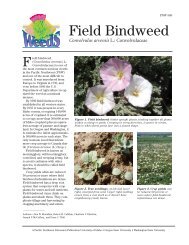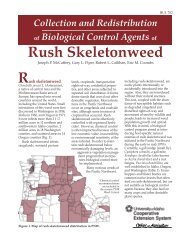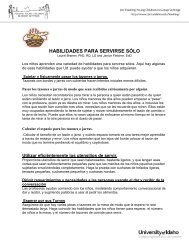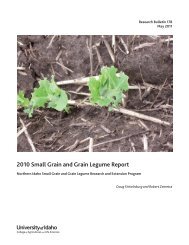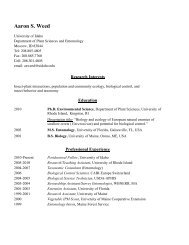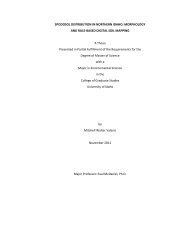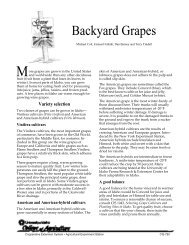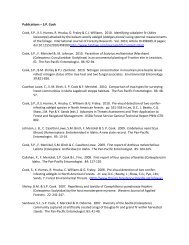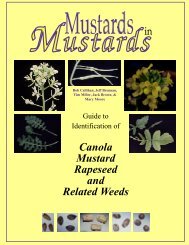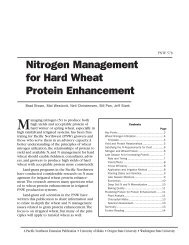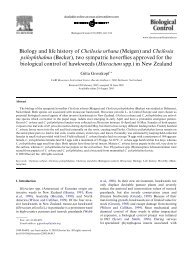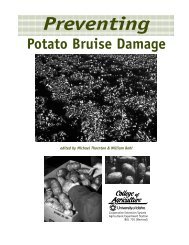Spring Barley Production Guide - College of Agricultural and Life ...
Spring Barley Production Guide - College of Agricultural and Life ...
Spring Barley Production Guide - College of Agricultural and Life ...
You also want an ePaper? Increase the reach of your titles
YUMPU automatically turns print PDFs into web optimized ePapers that Google loves.
However, after years <strong>of</strong> crop production, soil K level gradually<br />
declines. This decline should be evaluated <strong>and</strong>, if<br />
needed, corrected to ensure adequate K availability. <strong>Barley</strong><br />
requirements for K are lower than those <strong>of</strong> sugarbeets,<br />
potatoes, or corn, but barley will respond to applied K if<br />
soil test levels are below 75 ppm (Table 14).<br />
Sulfur<br />
Annual barley requirements for sulfur (S) are about 15<br />
times less than that for N. Sulfate-sulfur (SO4-S) is the<br />
form <strong>of</strong> S taken up by plants. Consequently, organic forms<br />
<strong>of</strong> S <strong>and</strong> elemental S fertilizers must be converted to SO4- S to be effectively utilized by plants. Sulfur availability in<br />
soils is affected by soil texture, organic matter, <strong>and</strong> leaching<br />
potential <strong>and</strong> by the S content <strong>of</strong> the irrigation water.<br />
Coarse-textured soils such as s<strong>and</strong>s are more likely to be<br />
low in S than fine-textured soils due to the greater susceptibility<br />
to SO4-S leaching. In many areas, the S content<br />
<strong>of</strong> the irrigation waters will be sufficient to satisfy the<br />
S requirements <strong>of</strong> spring barley. This is particularly true <strong>of</strong><br />
Snake River waters, which typically have relatively high<br />
amounts <strong>of</strong> S.<br />
Because <strong>of</strong> the mobility <strong>of</strong> SO4-S, soils should be<br />
sampled to a greater depth (24 inches) than that for immobile<br />
nutrients such as P <strong>and</strong> K. If the soil test S concentration<br />
is less than 10 ppm in a 0- to 24-inch soil sample,<br />
<strong>and</strong> S content <strong>of</strong> the irrigation water is low, such as in<br />
high-rainfall mountain valleys <strong>and</strong> foothill areas <strong>of</strong> southern<br />
Idaho, 20 to 40 pounds per acre <strong>of</strong> S should be applied.<br />
<strong>Barley</strong> irrigated with Snake River water or waters<br />
consisting <strong>of</strong> run<strong>of</strong>f from other fields typically will not need<br />
additional S for maximum yield.<br />
Sulfur deficiencies during the growing season can be<br />
determined with plant tissue analysis. The ratio <strong>of</strong> N to S<br />
concentrations in the plant tops should be 17:1 or less.<br />
Ratios greater than 17:1 indicate a S deficiency <strong>and</strong> S fertilizer<br />
applications should give a grain yield or quality response.<br />
Sulfur fertilizer should be applied in the sulfate<br />
form for most rapid plant use. A soluble S source may be<br />
applied through the irrigation system to correct in-season<br />
S deficiencies.<br />
Micronutrients<br />
<strong>Barley</strong> may respond to micronutrients if grown on severely<br />
eroded soils or where soil leveling has exposed<br />
light-colored calcareous subsoil. Micronutrients, especially<br />
boron, can <strong>of</strong>ten cause more harm than good if applied in<br />
excess. If using micronutrients, be sure to use correct<br />
rates <strong>and</strong> application procedures.<br />
IDAHO SPRING BARLEY PRODUCTION GUIDE<br />
26<br />
Table 13. Phosphorus application rates based on soil<br />
test P concentrations <strong>and</strong> free lime.<br />
Soil test 1<br />
Percent free lime 2<br />
0-12 inches 0 5 10 15<br />
ppm lb P2O5/acre<br />
0 240 280 320 360<br />
5 160 200 240 280<br />
10 80 120 160 200<br />
15 0 40 80 120<br />
20 0 0 0 40<br />
1<br />
NaHCO3 extraction.<br />
2<br />
Free lime content based on calcium carbonate equivalent.<br />
Table 14. Potassium application rates based on soil<br />
tests.<br />
Soil test K 1<br />
Potassium rates<br />
0 to 12 inches (ppm) (lb K2O/acre) 0 240<br />
25 160<br />
50 80<br />
75 0<br />
1<br />
NaHCO3 extraction.




